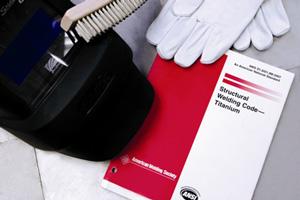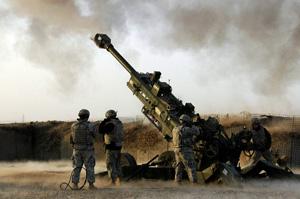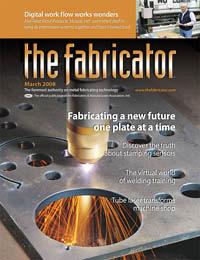- FMA
- The Fabricator
- FABTECH
- Canadian Metalworking
Categories
- Additive Manufacturing
- Aluminum Welding
- Arc Welding
- Assembly and Joining
- Automation and Robotics
- Bending and Forming
- Consumables
- Cutting and Weld Prep
- Electric Vehicles
- En Español
- Finishing
- Hydroforming
- Laser Cutting
- Laser Welding
- Machining
- Manufacturing Software
- Materials Handling
- Metals/Materials
- Oxyfuel Cutting
- Plasma Cutting
- Power Tools
- Punching and Other Holemaking
- Roll Forming
- Safety
- Sawing
- Shearing
- Shop Management
- Testing and Measuring
- Tube and Pipe Fabrication
- Tube and Pipe Production
- Waterjet Cutting
Industry Directory
Webcasts
Podcasts
FAB 40
Advertise
Subscribe
Account Login
Search
The facts on welding titanium
American Welding Society D1.9 Structural Welding Code is a new tool for welders' toolboxes
- By Stephen Luckowski and John Lawmon
- March 11, 2008
- Article
- Arc Welding
Many engineers and fabricators believe that titanium is a mysterious and difficult metal to weld—a fact that contributes to its exclusivity and relegates it to the high-end performance requirements of the aerospace market, the distance-driving desires of golfers, and the need-for-speed cycling world.
Experienced welders will tell you that it's not true. In fact, titanium welding techniques are very similar to those used for welding nickel alloys and stainless steels. Titanium also is easier to weld than many metallurgically more complex metals and alloys.
The origin of titanium's daunting reputation likely lies in the particulars for welding titanium: a higher melting point than other metals and alloys, precautions to avoid contamination during welding, and layers of shielding to prevent oxidation.
In spite of the precautions that need to be taken, a growing number of fabricators are more routinely and economically welding titanium, making sound, ductile welds at comparable rates to many other high-performance materials.
By all accounts, the manufacturing community finds titanium's properties attractive; it is clearly a metal on the rise. Over the last 18 months, tonnage sales and use of titanium have risen considerably, and even the most conservative projections indicate it will continue to climb in the coming years. Global demand is strong, and the overall market demand is expected to almost double in 10 years (see Figure 1), with a 34 percent increase from 2006 through 2010, according to Verkhnaya Salda Metallurgical Production Association, the Russian supplier of titanium.
Strong Material Choice
Titanium and titanium alloys' high strength and corrosion resistance are increasingly making them the metals of choice beyond traditional industries. The military is a significant and growing market for titanium-based weapons systems that protect U.S. soldiers from myriad threats in the global war on terror.
Multiple components on the U.S. Army's M777 155-mm lightweight howitzer (see Figure 2) and a series of gunner protection kits (see Figure 3) are examples of weapons systems components made of titanium. The titanium plays a crucial role in providing additional protection to various light tactical vehicles in the field.
The U.S. Department of Defense has funded many advances to reduce the prohibitively high cost of titanium through improvements in materials processing and fabrication, including alternatives to the traditional means of producing titanium parts, new alloys, single-melt processing techniques, and automated welding techniques that increase welding productivity at a fraction of the cost.
Yet, even with all the advances, many are still wary of welding titanium.
A Resource to Strengthen Titanium's Case
A new resource tool takes away the guesswork and the apprehension when welding titanium: The American Welding Society (AWS) D1.9/D1.9M Structural Welding Code—Titanium. Released in July 2007, the code goes beyond the limitations of previous documents by providing the information required to engineer a structural titanium product from start to finish—from design through manufacture and inspection—in the form of a structural code of reference.
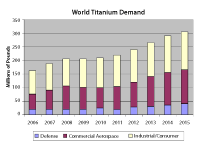
Figure 1 Demand for titanium is expected to increase dramatically in the coming years. Source: RTI International Metals.
The titanium code was developed using the same AWS process as the widely accepted AWS D1.1 Structural Welding Code—Steel and includes rules for design, qualification, fabrication, and inspection. It provides design, materials, and manufacturing engineers with the ability to employ titanium with greater confidence. It also can be used as a check list for purchasing agents to help maintain production costs.
According to John Gayler, director, National Standards Activities at the AWS, the code was initiated with a simple query to the AWS.
"The initial committee members and current co-chairs represented the titanium needs of the military market. However, they recognized an opportunity to support the controlled structural fabrication of titanium more widely in multiple markets with a defined set of processes and specifications in place for it to be welded with confidence," Gayler said. "And so they extended the invitation across multiple industries to help create a universally accepted code."
The entirely volunteer committee included representatives from the military, international fabrication industries, titanium manufacturers, Japan Titanium Society, end users, and the R&D community, as well as a series of technical advisers. The primary goal was to provide a new tool for the industry toolbox by providing a code of reference. The publication of the code also was seen as an effective way to boost titanium's reputation as a viable, usable, and weldable material.
Fabricators currently welding with titanium should reference the welding and fabrication sections, and the associated commentaries, to determine the suitability of their current fabrication techniques. The code defines the minimum quality requirements for welding and inspecting titanium in structural applications.
Quality control teams and nondestructive-testing specialists that are used to working with steels and nonferrous materials can use the code to fully understand titanium's unique metallurgical characteristics and the consequences of inappropriate manufacturing and inspection practices. Within the code are useful concepts to employ to check the weld quality produced and help drive a continuous improvement environment.
For engineers looking to build structural components, the code's fatigue design rules and inspection specifications can not only ensure that the product will be structurally sound, but also help them follow the proper design procedures to lower the overall cost of the project.
An "annex" to the code is written specifically for those designing and fabricating components or weapons systems for the military. "Welding of Titanium Armor Structures" addresses the unique design, qualification, and testing requirements for armor and includes a ballistic test plate design and testing method with acceptance and rejection criteria.
The code features testing details for multiple grades of titanium, including commercially pure grades 1 and 2, grade 5 Ti-6Al-4V, and grade 9 Ti-3Al-2.5V. It also provides a methodology that can be adapted for the fabrication of other popular structural titanium alloys under this code. Additionally, the code provides design criteria and allowable stresses for multiple types of welded connections and is applicable for multiple welding processes, including gas metal arc welding, gas tungsten arc welding, plasma arc welding, electron beam welding, and laser welding.
Perhaps one of the more critical areas of the code for those designing structures with complex geometries is the fatigue performance test data shown in Figure 4. This data can be used in conjunction with the numerous joint classifications detailed in the code to determine the estimated fatigue life.
Current fatigue data indicates that the weld 's toe profile and the direction of stress, compared to the connection, are of more significance than the grade or strength of the titanium. This data can increase the design engineer's confidence in employing titanium in both commercial and military applications. Such was the case with the M777 155-mm lightweight howitzer; using the fatigue data generated, design engineers proposed alternate manufacturing strategies.
In addition to providing a formal method for the development and approval of titanium welding procedures, a major goal of the AWS D1.9/D1.9M Structural Welding Code—Titanium is to boost the reputation of titanium as a usable metal.
A Stronger Argument for Titanium
Many design engineers are reluctant to propose expensive materials, such as titanium. Additionally, they do not understand the true cost of fabrication labor and manufacturing practices that can dwarf material costs, which leads to an intense focus on the price per pound of raw titanium. While titanium and its alloys are expensive raw materials, the benefits of using them accrue over time—the through-life cost—and can outweigh the raw materials cost.
To achieve the potential through-life cost savings, design engineers need to be aware of the detail contained within the code. Working with qualified welding engineers, designers can best integrate the code's design sections with the specifics of the welding fabrication and inspection sections.
While design engineers know a weld has to be made, some may not be fully aware of the significance of the type of weld or inspection method.
For example, it's easy to write on drawings "Radiograph, dye-penetrant, visual examination," etc., but unless the recommended inspection method is appropriate for the specific weld, the written directions can result in poor quality, wasted time, and increased costs. An understanding of the titanium weld inspection methods detailed in the code can help engineers design their structures more cost-effectively.
The code also offers weld engineers techniques for the examination of titanium welds, such as checking the color of the deposited weld metal. Color is not an issue with steel, but with titanium color can be an indicator of problems with the welding technique. Because different welding processes respond differently and create different levels of color on titanium, the guidelines used in context with the weld process can help welders quickly recognize and easily identify weld problems.
The detailed but clear provisions in the AWS D1.9/D1.9M Structural Welding Code—Titanium dispel the hard-to-work-with myth about titanium. The guideline is a one-stop shop for the proper design engineering, welding, and inspection of titanium welded components.
The AWS Titanium Welding Committee welcomes new members to participate in the process of updating the code with additional test data and to bring new ideas and developments into the document.
Titanium Weld Color:
A Potential Indicator of Weld Quality
A common question when welding titanium is, How important is the discoloration of the weld surface?
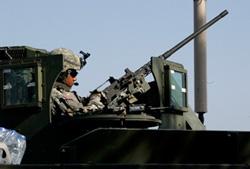
Figure 3 The new gunner protection kit, designed by the Armament Research, Development, and Engineering Center at Picatinny Arsenal, also uses titanium components.
Weld color can be an indicator of an unacceptable weld, but everyone involved in titanium fabrication—designers, engineers, welders, fabricators, and inspectors—should keep in mind that discoloration should be used as part of the decision-making process and not the sole factor in weld acceptance.
The chart below shows a range of colors that may develop when titanium is exposed to atmospheric conditions at elevated temperatures. The color change is an indication of the thickness of the surface oxide (rutile) that develops and, thus, an indicator of the degree of weld contamination that may have occurred. With minimal or no oxidization, the surface color will be silver or light straw, while in severe cases of oxidation, loose, flaky white or gray deposits form.
If a contract specifically requires evaluation of weld color, the AWS D1.9 Structural Welding Code— Titanium can be a useful reference. The code specifies the inspection requirements, qualifications, and responsibilities for individuals evaluating welds and provides detailed color acceptance criteria in the form of Table 5.3.
When discoloration is found in a weld, the welding team should examine the welding equipment, filler wire, and work environment to understand the cause. For example, a contaminated tungsten welding electrode is evidence that the quality of the primary shield gas has been compromised in the welding torch lines, whereas contamination at the end of the filler wire could be an example of a poor wire manipulation technique.
Ineffective shielding can lead to discoloration of the weld as indicated in the chart below. Possible causes of ineffective shielding are the location of the welding area, such as near a door or vent where the air current flowing across the weld can cause the inert gas shield to fail to some degree. It is imperative to perform welding in an area free from drafts to prevent hot weld metal from being exposed to atmospheric oxygen and nitrogen if bright, shiny silver welds with minimal contamination are required.
Unlike GTAW, GMAW presents new challenges to the issue of weld discoloration. GMAW produces a titanium vapor in the weld arc that deposits onto the cooler weld surface as finely divided titanium particles. Because of the reactive nature of titanium, these particles will combust spontaneously upon exposure to atmospheric oxygen once outside the protective weld gas shield. The nature of the resulting black deposit on the weld makes it difficult for inspectors to use color guidance charts as a reference for visual inspection of weld color. It is therefore very important that every manufacturer establish and approve welding inspection procedures applicable to the specific welding processes adopted.
Interested parties can contact the AWS to learn how to get involved. Go to http://www.awspubs.com to search for, preview, and purchase the code.
Stephen Luckowski is chief, prototype manufacturing team, Building 3150, Picatinny Arsenal, NJ 07806, 973-724-3100, stephen.luckowski@us.army.mil. John Lawmon is principal engineer, American Engineering and Manufacturing, 4622 French Creek Road, Sheffield, OH 44054, 614-846-5718,john.l@aemi.us.
About the Authors
subscribe now

The Fabricator is North America's leading magazine for the metal forming and fabricating industry. The magazine delivers the news, technical articles, and case histories that enable fabricators to do their jobs more efficiently. The Fabricator has served the industry since 1970.
start your free subscription- Stay connected from anywhere

Easily access valuable industry resources now with full access to the digital edition of The Fabricator.

Easily access valuable industry resources now with full access to the digital edition of The Welder.

Easily access valuable industry resources now with full access to the digital edition of The Tube and Pipe Journal.
- Podcasting
- Podcast:
- The Fabricator Podcast
- Published:
- 04/16/2024
- Running Time:
- 63:29
In this episode of The Fabricator Podcast, Caleb Chamberlain, co-founder and CEO of OSH Cut, discusses his company’s...
- Industry Events
16th Annual Safety Conference
- April 30 - May 1, 2024
- Elgin,
Pipe and Tube Conference
- May 21 - 22, 2024
- Omaha, NE
World-Class Roll Forming Workshop
- June 5 - 6, 2024
- Louisville, KY
Advanced Laser Application Workshop
- June 25 - 27, 2024
- Novi, MI
























